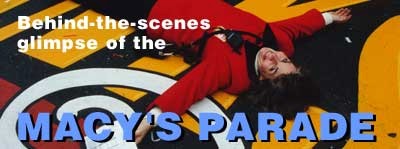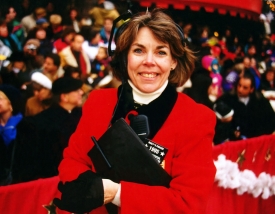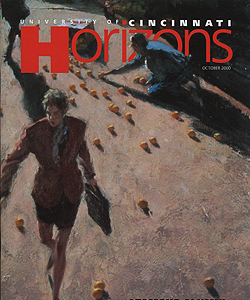A look at a great American tradition

Alyson Bristol has been inside Kermit the Frog's head. Not just figuratively speaking, trying to grasp how a Muppet thinks. But literally. In person. Physically walking around inside that little green head.
Well, actually, it was a great big head. The kind that gets filled with helium and goes bobbing down Broadway on Thanksgiving Day.
As vice president of Macy's annual events, Bristol, CCM '75, is associate producer of the company's annual Thanksgiving Day Parade, "the longest running show down Broadway," she says. The musical theater alumna from the University of Cincinnati traded in colleagues like Rock Hudson, Roberta Peters and Angela Lansbury to work with a frog. "The parade is an American icon," she says.
For 76 years, the parade has officially kicked off the Christmas season for many Americans who refuse to drink a drop of egg nog until Santa waves at the end of the parade. Last year, 2.5 million lined New York streets to wave back, and another 34 million watched the three-hour NBC spectacle that earned two Daytime Emmys in May.
The fall 2000 event will be Bristol's 14th parade, a responsibility she did not assume lightly, but one that caused her to give up a successful stage career. While singing and dancing were satisfying, something was missing, she says. Although she never suspected that Garfield and Bullwinkle would fill the void in her life, she eventually traded spotlights and curtain calls for the trials and triumphs of live television.
In the end, the career shift did not abandon her musical theater training, but more fully utilized it, Bristol explains. She credits her College-Conservatory of Music experience for enabling her to handle the diversity and magnitude of parade responsibilities -- producing, casting, directing, staging and dealing with music, costumes and makeup.
She still gets to work with stars, but now they are stars of stage, screen and recording studios who make guest appearances. She also gets to work regularly with big names from CCM because the parade telecast always features Broadway dance numbers. And any Broadway cast includes a CCM alum, she says. "We're everywhere. The Actors Equity (union) refers to us as the CCM Mafia."
Bristol quickly admits that working on the parade brings many joys, but just as quickly points out that it involves intense, year-round work, too. "Every day I do something related to the parade," she states.
To begin with, Macy's has a full-time theatrical production department, a design and construction studio in New Jersey with 15 full-time employees, as well as four warehouses to store 30 large floats and 25 Kermit-sized balloons, each one averaging 60 feet in length and 450 pounds in weight. In addition, 50 employees voluntarily serve on a parade committee all year long, and additional full-time employees are hired seasonally.

Still, those numbers are nothing compared to what happens in June. That's when recruitment begins for 4,000 employees to volunteer as clowns, balloon handlers, float escorts, celebrity escorts and other positions. In the end, volunteers will represent 47 Macy's stores from as far away as Boston, Pennsylvania and upstate New York.
Several months prior to that, 300 video submissions from around the world are viewed to select a dozen bands, and in August, Bristol starts scrutinizing Broadway shows, looking for musical numbers with both parade potential and costumes durable enough to handle unpredictable climate.
In October, the serious training starts: a "clown college" for 800 volunteer clowns, several "flight schools" for balloon handlers and choreography rehearsals for float escorts. In early November, balloon test flights are conducted and measurements taken to ensure all floats can collapse to 12 by 8 feet to fit through the Lincoln Tunnel. As an emergency precaution, backup film footage of each balloon is pulled to fill air time if needed. ("Underdog," for example, lost his superpowers after colliding with a light pole in 1975.)
A week before Thanksgiving, Bristol sits in on a script reading with telecast announcers and several planning sessions with NBC directors, the camera crew and 75 other production people. On Sunday, she actually moves into a local hotel "for the duration," as she puts it.
On Monday and Tuesday nights, streets periodically close for all kinds of parade rehearsals. Around noon Wednesday, street closures begin again for balloon inflation, followed by construction, more rehearsals and queues for floats. After dark, at Herald Square in front of Macy's, NBC workers construct a booth for the announcers and install track for 14 cameras.
At midnight, the pace quickens greatly. Police escort a military-type convoy of floats from New Jersey. While floats are reassembled, continuous rehearsals occur before cameras.
Harding Whitacre, CCM '66, knows about those rehearsals. As a band director for the Butler, Pa., high school marching band, he dragged 360 students out in full uniform at 2:30 a.m. in 1997.
"We ran through the show twice in front of cameras," he says, "then went out for breakfast, where we had the entire restaurant to ourselves." Afterward, the students piled in the eight buses they had parked along the street to grab a nap before reporting to Central Park to line up at 7:30 a.m. and "wait for the countdown."
"It was a great experience," he says. "And on a TV promo last year, there was a two-second glimpse of us, so we're still around."
Also in the pre-dawn hours, out-of-town employees start busing in, and around 5 a.m., visitors start grabbing the best seats while catching a few rehearsals. At the same time, Bristol, who stays up all night, meets staging crews and checks on balloons and floats. By 6 a.m., employees are donning costumes and getting into makeup.
Around 8:30 a.m., most people are in a holding pattern that involves holding their breath as much as anything. When Bristol hears "five minutes to air" through her headset at 8:55 a.m., her "stomach drops," she says, knowing that cameras will soon roll regardless of extenuating circumstances.
The most common form of disaster, she says, stems from a single parade motto: "Rain or shine, we never cancel."
Two years ago, that meant watching majorettes do the splits in puddles and repeatedly drying rain-spotted camera lenses in a 52-degree torrential downpour. In '85, many of the "splits" were accidental, as sleet glazed the pavement with ice. And in '97, a spectator suffered serious injury when wind gusts knocked over a light pole.
Only once during her watch did snow blanket the event, in '89, but it certainly wreaked havoc. Deep enough to keep buses off the road, the snow stranded a sizable corps of volunteer employees out of town.
Bristol credits the fact that TV viewers noticed few complications that year to the true holiday spirit exhibited by her volunteers. She gives an example of one store employee who bought tickets for 50 of her coworkers to take the train to Manhattan.
"Those people are what keep me going," Bristol says. "Remember, I get paid for this. But it could be raining, snowing, sleeting and miserable, and I'll see 4,000 people start showing up, oblivious to it all, just happy to be here, on the only day off they'll have for the next six weeks. It's amazing."
In all situations, Bristol has the daunting responsibility of keeping the show on track. That can mean knowing when to shave a few seconds of air time off a float or finding out who is driving James Bond's $130,000 car.
She can laugh, now, when recalling how a James Bond look-alike was supposed to drive a special BMW to promote a new movie. But when the time came for the car to start, the driver was missing.
Aware that schedules were critical, a parade captain gallantly jumped into the driver's seat -- a commendable gesture that turned comic when he accidently retracted the car's top without knowing how to put it back. Before panic set in, the authentic Bond-double was delivered via golf cart.
Bristol keeps tabs on such glitches by using a radio from her Herald Square station. She knows the one hour that entrants need to complete the 2.5-mile parade route before reaching TV cameras at the end leaves room for lots of complications.
Finally, when the clock strikes noon, she exhales and heads for a post-parade reception before watching the videotape of the telecast. "It is really the last of the great, live, TV entertainment specials," she says. "Live variety shows don't exist on TV anymore. The only things comparable are the Super Bowl halftime show and the Miss America pageant." (The show is live in the eastern time zone, but replayed at 9 a.m. in other time zones.)
That night, she falls into bed, knowing she must rise early again Friday to reach the store by 7 a.m. for the opening of Santa Land. Friday afternoon, she and other employees finally remember what the holiday was supposed to have been about as they gather for a belated Thanksgiving dinner at their New Jersey studio. "Working with creative geniuses" is one of the blessings for which she is most grateful, she says.
Bristol admits that the parade has grown so extravagant that it survives today only because of its strong tradition. "You could never recreate it from scratch," she says.
That single remark, though, is as close as she comes to mentioning money. The one question she refuses to answer is: How much does it cost to have Kermit and Santa kick off the holidays?
"The parade is a gift," she says matter of factly. Shaking her head slightly, as if reminding you of your manners, she adds, "You don't ask the price of a gift."

 Past Issues
Past Issues